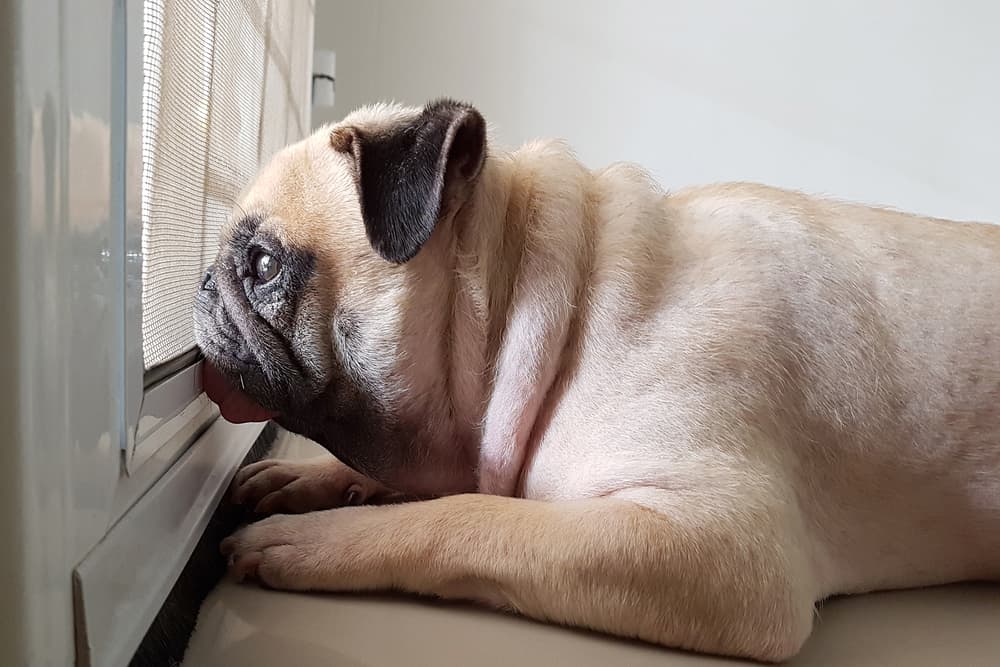Contents
All products and services on Project PAWS are independently selected by our editors, contributors, and veterinary experts. This post contains affiliate links. As an Amazon Associate I earn from qualifying purchases.To learn more, view my disclosure policy.
Last Updated on October 28, 2020 by Aimee
Separation Anxiety in Dogs: Dogs are social animals and form strong attachments to other dogs and people. Problems can arise when a dependent dog has a strong attachment to one person. Things that contribute are the following:
- Owner perhaps works from home or is retired and spend a lot of time with their dog.
- After a stressful period, for example, when the owner’s schedule changes so that the dog is left more frequently.
- Move to new home.
- Change in family dynamics, child leaves for college, divorce or deployment are all things that can stress a dog.
Signs of separation anxiety
This is seen in the owner’s absence. There is a high state of anxiety in the dog, and the dog feels a need to do something to reduce the tension. This may manifest in a variety of behaviors such as:
- Chewing
- Digging
- Pacing
- Panting
- Escaping
- Lethargy
- Urination and/or defecation
- Scratching at the door
- Destroying objects

All of these things are merely a dog’s way of trying to calm itself in your absence. The dog is not trying to “get back at you” for anything. Never punish a dog for destructive behaviors done in your absence. This will only make matters much worse and add to the dog’s already overwhelming anxiety.
Reduce the Anxiety
Dogs with separation anxiety require significant amounts of fast-paced aerobic activity in order to help them relax when you are gone and ideally should happen before you leave. The idea is to make the tired so they don’t destroy things while you are gone. Two or three 20-30 minute exercise sessions are best. Take the dog for a fast walk on a leash or engage your dog in a fast-paced game of fetch. Even if your dog has a large yard to run in, there is no guarantee that he is getting enough activity. When left to their own devices, most dogs do not get regular sustained aerobic activity.
- Don’t say “goodbye” or make a big fuss over your dog when you leave for the day. This reinforces the idea that your leaving is a big event and is something to be concerned about. If you seem concerned, sad or anxious about leaving your dog will pick up on it and mimic this.
- Obedience train for 5-10 minutes twice daily. Positive training can be very beneficial because it helps build confidence
Practice Leaving
- Train and practice lots of “sit”, “down” and “stay” with your dog in your house
- Gradually increase the distance between you and your dog slowly moving around your dog while they remain in the sit or down stay. Your goal is to teach your dog that they can remain calmly and happily in one place while you are physically separated. (not out of the room unless only a few seconds).
- Start simply while you’re watching TV with your dog down by your side, you can tell them to “sit-stay” or “down-stay,” offer treats or a chew, and then slowly (start with 15 seconds) move about the room.
- When you return to your dog, release them with the word “okay”. It is vital your “release” your dog with a direct look and vocal word, don’t just finish walking around and return. Your dog needs to learn that stay means don’t move until they hear the work release. This teaches them the cue to move only happens when you tell them.
Master the “stay”
The stay command can be very difficult for some dogs so here are some tips for helping them understand even when you are not within 5ft they will be fine.
- create some distance between you and your dog by using a baby-gate setup, a crate.
- put your dog on a tether for a brief time several times per day. During these times, do not leave the room completely. You are not leaving your dog alone; your dog should still be able to see you. You are simply creating some space between you.
- Don’t look at or talk to your dog if they are whining or barking. Do not approach or engage them unless they are being calm
- Give them a wonderful chewy (i.e. a bully stick) or frozen peanut butter- filled kong or cream cheese-filled twist ‘n treat just before you walk away.
- Stay within view and don’t go out of view unless only momentarily. Practice multiple times per day for 15 – 20 seconds. SLOWLY over time, build up to 30 seconds and then several minutes.
Be careful not to rush this process.
- Return to your dog before they starts to lose interest in the chew or toy. Every time they loses interest and begins to look for you, they start the panic sequence. Err on the side of caution, and return well before you think you need to.
- Pick the item up first thing when you come back to your dog, and then release them from the crate, tie-down, or baby gated area. Be VERY careful not to make a big fuss over your dog when you come back to release them. Just open the gate or door and walk away.
- Everyone, especially the person most attached to the dog, should ignore the dog for 2-3 minutes before leaving and upon returning home. If it isn’t a big deal to you, your dog will learn it isn’t something to have anxiety about. Ignoring means not looking at, talking to, or touching your dog. This helps reduce the dog’s excitement level before you leave and after your return, which reduces the tension they feel when you are gone.
- Greet your dog on when they are calm, if the greeting excites them stop the greeting and walk away.

Make your house feel like when you are home
- Turn on the TV (animal planet) or radio whether you are home or not. You may even want to try tuning into DogTV.com (a channel created just for our dogs!)
- You may also find music specifically created for dogs with separation anxiety, such as the download mp3 “Music through a Dog’s Ear”.
- Record your morning or evening routine with an audio device, play back on a loop while you are gone.
Natural Remedy help for Separation Anxiety in Dogs
- Animal’s Apawthecary Tranquility Blend. A safe, balanced combination of four calming nerve tonics for acute anxiety disorders.
- HomeoPet. A safe, non-sedating homeopathic remedy used for separation anxiety.
- Dog Appeasing Pheromone. A plug-in or spray that mimics the natural pheromones produced by the mother during the first few days of a pup’s life. Reduces or completely stops stress-related behavior in approximately 66% of dogs tested. I highly recommend that you buy the spray (for bedding) and for use on a bandana that the dog wears daily.
- Separation Anxiety or Rescue Remedy Bach Flower Essence. Designed to bring relief to animals exhibiting symptoms of separation anxiety.
- Vetri-Science Liquid Calming Formula for Dogs. Combines ingredients not found in other formulas, including B-vitamins, lecithin, and L-theanine.
- Aromatherapy products containing lavender and chamomile. Spray it on bedding and a bandana that your dog wears around his neck.
- Relaxiherb. This is a wonderful complementary herbal which may be used in conjunction with the dog appeasing pheromone. It does not sedate, but it does calm most dogs nicely. Combines safe and effective herbals such as valerian, hops, and passion flower leaf. Give by dropper directly into your dog’s mouth about 25 minutes prior to your practice sessions. For best results, I recommend using 1-1/2 times the amount suggested on the bottle.
- Zesty Paws Calming Bites. These tasty chews are flavored with real turkey and formulated with a special blend of all-natural ingredients proven to help dogs feel calm with no drowsiness or drugs. It contains Suntheanine, a pure form of the amino acid L-theanine that supports stress-free relaxation, along with a special blend of calming nutrients and plants including vitamin B1, organic hemp and chamomile, valerian root and l-tryptophan.


1 comment
Thank you for this useful information.